University of Hyderabad
The University of Hyderabad (IAST: Haidarābād visvavidyālayamu) is a public research university located in Hyderabad, Telangana, India.
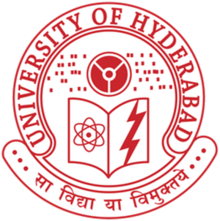 | |
| Motto | Sā vidya ya vimuktaye |
|---|---|
Motto in English | "Education results in liberation." |
| Type | Public |
| Established | 1974 |
| Chancellor | L. Narasimha Reddy |
| Vice-Chancellor | Appa Rao Podile |
| Students | 5000[1] |
| Location | Gachibowli, Hyderabad , , |
| Campus | 2,300 acres (9,300,000 m2) Urban |
| Affiliations | UGC, NAAC, AIU, ACU |
| Website | www.uohyd.ac.in |
Founded in 1974, this mostly residential campus has more than 5,000 students and 400 faculty, from several disciplines.[1] The Governor of the state of Telangana is ex-officio the Chief Rector of the University, while the President of India is the Visitor to the University.
The university was established along the lines of the Six-Point Formula of 1973. The first Vice-Chancellor of the University was Banaras Hindu University organic chemist Gurbaksh Singh, from 1974 to 1979. Shri B D Jatti was the first chancellor of the University.
In January 2015, the University of Hyderabad received the Visitor's Award for the Best Central University in India, awarded by the President of India.[2]
The university is located in Gachibowli, on 2300-odd acres. The campus is rich in flora and fauna, home to over 734 flower plants, ten species of mammals, fifteen species of reptiles,[3] and 220 species of birds.[4]
The University is recognized as an Institute of Eminence (IoE)[5] by the University Grants Commission (UGC) through the UGC (Declaration of Government Institutions as Institutions of Eminence) Guidelines, 2017 for public institutions[6]
Academics
Teaching and learning
The University follows the semester calendar beginning in mid-July and ending in early-May. About 90% of the students are residential. The Master's programme is usually of 2 years while the M.Phil and Ph.D programme are of 18 months and 5 years respectively.
The University follows the continuous assessment pattern, with 40% marks awarded through assignments spread out through the semester and 60% through semester-end examinations. Grading is on a 10.0 point scale, with D being the lowest passing grade, and A+ being the highest. The toppers post-graduate courses are awarded medals.
Admission
The University is primarily a post-graduate research university. UoH conducts its own entrance examinations for all courses during the months of May–June each year and interviews in the month of May annually. The University offers Integrated M.Sc, M.A, MSc, M.F.A, M.Tech, M.B.A, M.C.A, M.Phil and Ph.D degrees. Admissions to UoH are highly competitive. The University follows the positive-discrimination reservation system as per University Grants Commission of India guidelines.
Rankings
| University rankings | |
|---|---|
| General – international | |
| QS (World) (2020)[7] | 601-650 |
| General – India | |
| NIRF (Overall) (2020)[8] | 15 |
| NIRF (Universities) (2020)[9] | 6 |
The University of Hyderabad was ranked 601-650 in the QS World University Rankings of 2020.[7] It is ranked 15 in India overall[8] and sixth in India among universities by the National Institutional Ranking Framework in 2020.[9]
Schools and departments
School of Mathematics and Statistics
The School offers facilities for intensive training and research in the basic areas of Mathematics (including Applied Mathematics), Statistics and Operations Research (OR).[10]
School of Physics
The School of Physics has teaching programmes at the M.Sc. and M.Tech. levels, and has research programmes to train Ph.D. scholars. The School conducts research in many areas of physics.[11]
School of Chemistry
The School of Chemistry admits students to its M.Sc. and Ph.D. programmes. The school's curriculum covers all branches of chemistry in keeping with the interdisciplinary nature of the subject today.[12]
School of Life Sciences
The School of Life Sciences has been established with an emphasis on interdisciplinary teaching and research in modern biology.
The School consists of four Departments:
- Department of Biochemistry
- Department of Plant Sciences
- Department of Animal Biology
- Department of Biotechnology and Bioinformatics
- Department of Systems and Computational Biology
Each of the departments offers M.Sc. and Ph.D. programmes of study.[13]
School of Management Studies
School of Management Studies has teaching programmes for MBA, MBA Business Analytics, MBA Health Care, Executive MBA and PhD.[14]
School of Humanities
School of Humanities comprises the following Departments, Centres and Cells:
- Department of English
- Department of Philosophy
- Department of Hindi
- Department of Telugu
- Department of Urdu
- Department of Sanskrit Studies
- Centre for Applied Linguistics and Translation Studies
- Centre for Comparative Literature
- Centre for English Language Studies (CELS)
- Human Values Cell
- Centre for Endangered Languages & Mother Tongue Studies
- Centre for Dalit and Adivasi studies and Translation
The School of Humanities aims at providing a centre of common awareness, a sense of human responsibility, and is committed to the achievement of linguistic excellence, creativity, and all-round development of students.[15]
School of Social Sciences
The School of Social Sciences comprises the following Departments and Centres:
- Department of History
- Department of Political Science
- Department of Sociology
- Department of Anthropology
- Department of Education and Education Technology
- Centre for Regional Studies
- Centre for Folk Culture Studies
- Centre for the Study of Indian Diaspora
- Centre for Study of Social Exclusion and Inclusive Policy
- Centre for Knowledge Culture and Innovation Studies
- Centre for Human Rights
- Centre for Gandhian Economic Thought
- Centre for Ambedkar Studies
The departments of Political Science and Sociology have been recognised by the University Grants Commission for the Special Assistance Programme.
The Department of Anthropology has developed a museum as a teaching aid for students.
The Human Rights Programme functions under the auspices of the Political Science department and the Centre for Indian Diaspora.
There is an interdisciplinary Women's Studies Cell, which takes up research projects on gender issues. An Archival Cell, for preserving rare and valuable manuscripts, functions, with the support of the University Grants Commission (UGC), under the auspices the Department of History.
In Academic Year 2007-2008, a five-year Integrated Programme in Social Sciences was begun, as a part of the Centre for Integrated Studies, leading to a master's degree in History, Political Science, Sociology, and Anthropology. For the first two years the students admitted to the programme do courses offered by various departments in the School, as well as other schools in the University. At the end of two years, students branch out to departments of History, Political Science, Sociology, and Anthropology, after fulfilling prerequisites stipulated by the departments.[16]
Sarojini Naidu School of Arts & Communication
The Sarojini Naidu School of Arts & Communication[17] started functioning from 1988–89 and offers Masters-level courses in Dance, Theatre Arts, Painting and Communication and Ph.D. programmes in Communication, Theatre Arts, and Dance.
The school consists of the following departments:
- Department of Dance
- Department of Theatre Arts
- Department of Fine Arts
- Department of Communication
The University is indebted to the family of Sarojini Naidu for the bequest by the late Padmaja Naidu of the "Golden Threshold", where the University started functioning. In recognition of this gesture, the University started this School by naming it after Sarojini Naidu to offer postgraduate and research programmes in the fields of arts and culture.
The School provides courses of study in the disciplines of, Dance, Theatre Arts, Painting and Sculpture and Communication. It seeks to enlarge the scope of the academic programme so as to include other areas of artistic endeavor like music. The broad objective of the teaching programme is not only to explore the evolution and forms of arts, but also to bring about an integrated approach to the study of creativity. An inter-disciplinary approach is incorporated in the syllabus. Apart from the core faculty, experts in various fields and guest faculty of national and international repute teach courses in the School.
Department of Communication
The Department of Communication,[18][19][20] located within the prestigious Sarojini Naidu School Arts & Communication, has evolved over the last 20 years of its existence, into one of the leading institutions of higher learning in the field of communication and media studies in India. The Department offers programmes leading to Masters and Doctoral degrees.
The department offers a two-year M.A Communication. Students who join the programme can specialise in one of the three streams of specialisation:
- Radio & Television
- Print Journalism & New Media
- Communication & Media Studies
The department also offers a Ph.D programme that is open to all M.A. Mass Communication & Journalism, Communication graduates conducting research in areas that cut across humanistic and social science methods.
UNESCO Chair on Community Media
Recognising the growing impact of the Community Radio phenomenon as a powerful medium of community engagement and empowerment, UNESCO has set up the first ever Chair on Community Media at the Department of Communication,[21] Sarojini Naidu School of Arts and Communication, University of Hyderabad, India.[22][23] Established for an initial period of four years in 2011, the Chair will serve as a knowledge and resource centre delving into the various facets of Community Media.
Bol Hyderabad Community Radio Station
Bol Hyderabad 90.4 FM is the University of Hyderabad's Campus Radio Station which began operations from 15 August 2011.[24][25] The range of the radio broadcast is around 15 kilometer radius around the campus covering areas of Tolichowki, Gopanapally, Hi-Tech City and Gachibowli areas of Hyderabad.[26][27]
School of Engineering Sciences and Technology
This School consist of one department, the department of Materials Engineering. It offers research programmes in Materials Engineering leading to MCA, M.Tech and Ph.D. degrees.[28]
School of Computer and Information Sciences
This school offers facilities for intensive training and research, in all major areas of computer science, for M.Tech, Integrated M.Tech, MCA, and Ph.D. students.[29]
Research
The university is a public research university with high research activity in every department, awarding about 300 doctorates each year. The university receives research funding from UGC, CSIR, DST, DBT, FIST and other funding agencies. The university is known for high quality research output from faculty and students in the natural sciences, social sciences, and humanities.
National Institute of Animal Biotechnology
National Institute of Animal Biotechnology (NIAB)[30] is an autonomous institute under the Department of Biotechnology,[31] Ministry of Science and Technology,[32] Government of India established in the campus of University of Hyderabad.
Institute of Life Sciences
The Institute of Life Sciences (ILS) also known as Dr. Reddy's Institute of Life Sciences is a research organisation founded through a public–private partnership initiative in the year 2004. The partners in the making of ILS are the Government of Telangana the University of Hyderabad and Dr. Reddy's Laboratories. Incorporated as a not-for-profit company, ILS has been accorded recognition as a Scientific & Industrial Research Organisation (SIRO) by the Ministry of Science & Technology.[33]
CR Rao Advanced Institute of Mathematics, Statistics and Computer Science
The CR Rao Advanced Institute of Mathematics, Statistics and Computer Science (AIMSCS) has been set up with the objective of promoting research and advanced studies in mathematics, Statistics, Computer Science and allied subjects.[34]
Association of Management Development Institutions in South Asia
The Association of Management Development Institutions in South Asia (AMDISA)[35] is a SAARC-recognised body. The association was established on the initiative of leading management Schools in the SAARC region and is located on the University of Hyderabad Campus in Gachibowli. AMDISA promotes management education and Management Development in the SAARC region and publishes the South Asian Journal of Management.[36] The mission of AMDISA is to network management schools and management development centres; to promote partnerships between the schools, leading managers, and policy administrators; and to enhance the quality and effectiveness of management education and development in South Asia. The permanent secretariat is located on the University of Hyderabad campus and is headed by an executive director. The secretariat is built on 2 acres of land, obtained from the university. The conceptual design of AMDISA's secretariat complex is representative of the SAARC spirit, with seven rooms networked into a central dome. The design envisages the seven rooms as representing the culture of each of the SAARC nations. While the secretariat serves the membership and initiates activity planning, its activities are hosted by member institutions in different countries of South Asia.
Library
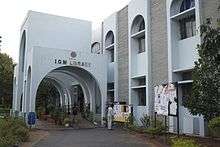
The university library is a central facility to support teaching and research activities of the University. This present library building was inaugurated by his Excellency late Shankar Dayal Sharma, the then Vice President of India, on 21 October 1988 and named after late Prime Minister Indira Gandhi.
The Library is connected to Campus Network. The library also created learning environment by establishing Online Public Access Catalog (WebOPAC), OPAC Searching Area, Internet browsing area, Laptop zone with Wi-Fi facility, specialised workstations & software for visually-challenged students and by facilitating electronic resources, search services/tools.
Indira Gandhi Memorial library is the first automated university library in the country. The library serves as a resources station to all scholars and has a print collection around four Lakhs that include monographs, text books, back volumes of journals, theses / dissertations, CDs/DVDs. It subscribes around 500 print journals in various disciplines of the university and provides access to more than 25000 e-resources including e-books. It also comprises a reading room which is accessible round-the-clock for the benefit of the students.
The Integrated Master's Programme
College for Integrated Studies (CIS)[37][38] was established in the year 2006 to offer 5-year Integrated master's degree courses. The Centre offers 5-year integrated master's degree courses in Science, Humanities and Social Science subjects. The five-year Integrated M.A. (I.M.A.) and M.Sc. (I.M.Sc.) courses of the University of Hyderabad are trans-disciplinary programmes with core and elective subjects.
SIP: The Study in India Programme
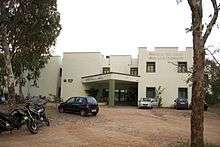
The University of Hyderabad's Study in India Programme (SIP) for foreign students began as a small experimental summer initiative where students from the University of Pittsburgh took nine credits over nine weeks in the summer of 1998. Since then, SIP has grown in leaps and bounds and has gone from hosting eight students in its debut year to nearly 200 in the most recent academic year. The University Grants Commission (UGC), a governmental organisation in India tasked with determining and maintaining standards for university education, has hailed the Study in India Programme as a model initiative and has encouraged other universities in India to emulate the program's approach. SIP's strength is its flexibility and willing to innovate to meet the needs of universities and study abroad consortia. SIP has created specialised, tailor-made programs for partners such as Dartmouth College, Duke University and the Nordic Centre in India—a consortium of 15 Nordic universities. Students can apply on their own, through their home schools, or through study abroad consortia that are SIP partners.
In 2014 the SIP Programme has been selected for IIE Andrew Heiskell Award. Thirteen Campuses in the world have been recognised for their Outstanding International Initiatives. UoH is the only University from Asia to be recognised. [39]
Centre for Distance and Virtual Learning
The University of Hyderabad started offering Post Graduate Diploma Programmes through distance mode since 1994. The target groups identified for these Programmes are (a) In service personnel looking forward to improve their skills and knowledge to enable to go up in the ladder in their own organisation or elsewhere and (b) Fresh graduate intending to improve their chances of employments on successful completion of these programmes.
Academic Staff College
Established in 1987 as a major initiative in augmenting quality in Higher Education, the UGC promoted 66 Academic Staff Colleges. The Academic Staff College of University of Hyderabad is a constituent unit of the University offering Orientation, Refresher and need-based courses for Assistant Professors / Associate Professors working in Universities and Colleges.
It is an important academic wing of the University. Apart from the training programmes for teachers, the Academic Staff College conducts Professional Development Programmes for Principals and Administrators. The faculty is also taking up the teaching assignments and research guidance in their respective departments. National Assessment and Accreditation Council (NAAC) Peer Review Committee from Ministry of Human Resource Development (MHRD) visited Academic Staff College during 19 – 21 January 2012 for peer reviewing of its activities and accredited this Academic Staff College, University of Hyderabad as ranked no. 4 in India.
Hostels, canteens and recreational centres
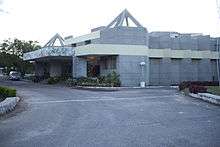
There are 21 hostels for students to stay in (13 for men and 8 for women). The Tagore International House caters to international students. There are two shopping complexes: one on the North campus and one on the South Campus. Also, there are seven canteens: the Students Centre Canteen, Goodwill Canteen, SN school canteen, F canteen, School of Chemistry canteen, Admin canteen, and School of Life Sciences canteen.
There are four multipurpose auditoriums within the campus. The DST Auditorium is the largest, with a capacity of 700. It is used mainly for cultural events, seminars, public talks, and screening of documentaries and movies. The CV Raman Auditorium, with a capacity of 200, is located inside the science complex, and serves as a conference and seminar hall. The BR Ambedkar Auditorium is mainly used for cultural events, public talks, debates, and other events. There is another auditorium located inside the humanities block.
National Service Scheme Cell (NSS)
In connection with 'Gandhi Jayanti Week' Celebrations National Service Scheme (NSS) Cell, organises Peace March, Orientation Programmes, Tree plantation etc. during the first week of October every year.
Students' Union
Major student organisations on the campus include the Ambedkar Students' Association (ASA), Students Islamic Organisation of India (SIO), Muslim Students' Federation (MSF), Akhil Bharatiya Vidyarthi Parishad (ABVP, "All Indian Student Council"), National Students' Union of India (NSUI), Students' Federation of India (SFI), Bahujan Students' Front (BSF), Dalit Students' Union (DSU), Telangana Students' Association (TSA), Other Backward Classes Federation (OBCF), All India Students Association (AISA ), and the Telangana Vidyarthi Vedika (TVV, Telangana Student Forum).[40]
The Students' Union is elected annually, with elections being conducted by the students themselves, following the guidelines set by the Lyngdoh Committee.[41] The Students' Union includes a President, Vice-President, General Secretary, Joint Secretary, Sports Secretary and Cultural Secretary. The elections are held during the month of September every year.
Student activities
The elected Students' Union conducts various sports and cultural events for the students over the academic year.
Nari's Knight Cup[42]
The first of such event is the Nari's Cricket Knight Cup. The tournament is named in memory of an Ex-student Mr.Narayan Reddy (Nari) who met with an unfortunate death in the campus premises. Initially, a few friends of Mr.Narayan Reddy started this 5-over a side tournament with 9 players per side. However, the Students' Union took over the responsibility of conducting the Knight Cup later. The tournament is conducted under floodlights at the Open-Air auditorium.
Senthil Balraj Cricket Night Cup
The Senthil Balraj Cricket Night cup was initiated in February, 2011 by the then Students' Union in memory of Senthil and Balraj. This cricket night cup is unique in the sense that it is open to only the registered students and employees of the University while the Nari's Knight Cup is open to Alumni's as well as the students of the University. However, the format of both the competitions remains the same.
Football Night Cup
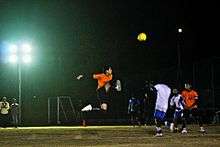
The Football Night cup is the third in the series of Night cups conducted by the Students' Union. The tournament is usually conducted in the last week of February every year. This is a 7-a-side tournament with a total match duration of 30 mins.
Basketball and Volleyball Night cup
The Union also conducts Basketball and Volleyball night cups every year in the month of March.
Cultural festival
Sukoon[43] (सुकून, meaning peace)is the annual cultural festival of the University organised by the Students' Union during the month of March where students from colleges all over Hyderabad participate. The 3-day event includes various literary and other recreational events like 'Mr.& Ms.Sukoon Competition', Rangoli, Shayari, Quiz, Antaakshari, Debate in English-Telugu-Hindi-Urdu, Dance, Singing, Spot Painting, Treasure Hunt etc. Traditional dance and music performance are also an integral part of the festival. Esteemed artistes such as Warsi Brothers, Telangana Troop etc. have been invited over the past years. The penultimate night is reserved for the Rock Show. Bands like Underground Authority, Motherjane, Taksha, Divine Connection etc. have performed during the past 5 years. The festival concludes with the DJ night.
Entrepreneurship Development Cell
The university has an ED Cell, located in the Management Block of the university, that has nurtured startups. Some of them include.[44]
Campus
The university campus on 2300-odd acres, has a large area under forest cover, with two perennial and three seasonal lakes, as well as rock formations characteristic of the Deccan. It is home to 734 plant,[3] 10 mammal, 15 reptile and 220 bird[4] species (at last count). Notable animals include spotted deer, hares, peacocks, porcupines and wild boar. The campus also has a protected megalithic site.[47]
A study, which ranged over three decades (1990-2010), reported that of the plants present on campus, 315 species were used in traditional Indian medicine. 39 species of plants belong to the group that face the threat of extinction. These listings were the result of field studies done on campus by students and faculty members.
The university has plans to preserve area under forest cover and wetlands by creating a bio reserve.[48]
Controversies
On 22 March 2016, police arrested 25 students and 2 faculty members who were reportedly protesting peacefully against the Vice Chancellor Appa Rao Podile's return to campus following the suicide of Rohith Vemula.[49][50] All of them were granted bail on 28 March by the Metropolitan Magistrate at Miyapur court.[51]
Chancellors
- B D Jatti, 1974–1979
- G Parthasarathy, 1982–1986
- M Hidayatullah, 1986–1991
- J R D Tata, 1991–1993
- Abid Hussain, 1994–1997
- Romila Thapar, 1997–2000
- P. N. Bhagwati, 2001–2005
- M N Venkatachaliah, 2005–2008
- R. Chidambaram, 2008–2012
- C. H. Hanumantha Rao, 2012–2014
- C. Rangarajan, 2015–2018
- L. Narasimha Reddy, 2018–present
Vice chancellors
- Gurbaksh Singh, 1974–1979
- B S Ramakrishna, 1980–1986
- Bhadriraju Krishnamurthi, 1986–1993
- Goverdhan Mehta, 1993–1998
- Palle Rama Rao, 1999–2002
- Kota Harinarayana, 2002–2005
- Seyed E Hasnain, 2005–2011
- Ramakrishna Ramaswamy, 2011 – 29 January 2015
- E Haribabu, 29 January - 31 May 2015
- R P Sharma, 1 June - 22 September 2015
- Appa Rao Podile, 23 September 2015 – present[52]
Notable alumni, faculty, and staff
- Girish Agarwal, FRS
- D Sridhar Babu, Former Minister, Govt of Andhra Pradesh
- Rahul Banerjee (chemist), Shanti Swarup Bhatnagar laureate[53]
- Dipankar Chatterji, recipient of Padma Shri and Shanti Swarup Bhatnagar Prize[54]
- Goverdhan Mehta, FRS
- G. Naresh Patwari, chemist and Shanti Swarup Bhatnagar laureate[55]
- D. Srinivasa Reddy
- G. Narahari Sastry, Bhatnagar Prize winner
- Shanta Sinha, Ramon Magsaysay Award winner
- Adusumilli Srikrishna[56]
- Mallu Bhatti Vikramarka
- Geeta Kashyap Vemuganti, Ophthalmologist, N-Bios laureate[57]
- Rohith Vemula, Dalit activist
- Ganesh Bagler, a prioneer of computational gastronomy
- Lavanya Vemsani, Historian, Professor of History at Shawnee state university, President-elect of Ohio Academy of History,
- Syed Akbaruddin, former permanent representative of India at the United Nations,
See also
- Education in India
- Distance Education Council
- University Grants Commission (India)
- Bhartendu Academy of Dramatic Arts
References
- "About University of Hyderabad". University of Hyderabad. 2012. Retrieved 25 April 2016.
- UoH is India’s best Central varsity
- "Land alienation threatens University of Hyderabad's flora and fauna". Times of India. 29 October 2012. Retrieved 11 October 2015.
- "Ebird hotspot - University of Hyderabad". EBird. Retrieved 18 June 2017.
- Werner, Jon M.; Anderson, Valerie; Nimon, Kim (14 February 2019). "Human Resource Development Quarterly and human resource development: Past, present, and future". Human Resource Development Quarterly. 30 (1): 9–15. doi:10.1002/hrdq.21340. ISSN 1044-8004.
- Sridharan, E.; Vaishnav, Milan (18 May 2017), "Election Commission of India", Rethinking Public Institutions in India, Oxford University Press, ISBN 978-0-19-947437-0, retrieved 7 March 2020
- "QS World University Rankings 2020". QS Quacquarelli Symonds Limited. 2019. Retrieved 1 October 2019.
- "National Institutional Ranking Framework 2020 (Overall)". National Institutional Ranking Framework. Ministry of Human Resource Development. 11 June 2020.
- "National Institutional Ranking Framework 2020 (Universities)". National Institutional Ranking Framework. Ministry of Human Resource Development. 11 June 2020.
- "School of Mathematics and Statistics". University of Hyderabad. 2012. Retrieved 27 April 2018.
- "School of Physics". University of Hyderabad. 2012. Retrieved 27 April 2018.
- "School of Chemistry". University of Hyderabad. 2012. Retrieved 27 April 2018.
- "School of Life Sciences". University of Hyderabad. 2012. Retrieved 27 April 2018.
- "School of Management Studies". School of Management Studies, University of Hyderabad. 2020. Retrieved 13 June 2020.
- "School of Humanities". University of Hyderabad. 2012. Retrieved 27 April 2018.
- "School of Social Sciences". University of Hyderabad. 2012. Retrieved 27 April 2018.
- Dundoo, Sangeetha Devi. "Museum culture is non-existent here". The Hindu. The Hindu. Retrieved 24 October 2015.
- Henry, Nikhila. "The Department of Communication at the Sarojini Naidu School of Arts & Communication". The Times of India. Retrieved 24 October 2015.
- "Department of Communication - University of Hyderabad". Department of Communication - University of Hyderabad. Department of Communication. Retrieved 24 October 2015.
- "Department of Communication, Sarojini Naidu School of Performing Arts, Fine Arts and Communication". Academia. Academia. Retrieved 24 October 2015.
- "EAC-UNESCO Community Media Network Workshop Gets Underway in Arusha". Star Africa PR Newswire. East African Community Secretariat. Retrieved 24 October 2015.
- Elliott, Patricia. "First-ever UNESCO community media chair named". J-Source. Canadian Journalism Project.
- "UNESCO Chair on Community Media". UNITWIN. UNESCO. Retrieved 24 October 2015.
- "University of Hyderabad revives old radio culture". Times of India. Times News Network. Retrieved 24 October 2015.
- Nair, Deepti. "UoH's Bol Hyderabad to fill airwaves". The New Indian Express. The New Indian Express. Retrieved 24 October 2015.
- Murthy, Neeraja. "Community bonding". The Hindu. The Hindu. Retrieved 24 October 2015.
- Mishra, Heena. "Hyd colleges warming up to campus radio". The Hans India. The Hans India. Retrieved 24 October 2015.
- "School of Engineering Sciences & Technology". University of Hyderabad. 2012. Retrieved 27 April 2018.
- "About Us". University of Hyderabad, School of Computer & Information Sciences. 2012. Retrieved 24 October 2018.
- "NIAB". NIAB. NIAB. Retrieved 24 October 2015.
- "Department of Biotechnology". Department of Biotechnology. Department of Biotechnology. Retrieved 24 October 2015.
- "Department of Science and Technology". Department of Science and Technology. Department of Science and Technology.
- "About Us". DR.REDDY's Institute of Life Sciences. DR.REDDY's Institute of Life Sciences. Retrieved 24 October 2015.
- "C.R.Rao Advanced Institute of Mathematics, Statistics and Computer Science (AIMSCS)". C.R.Rao Advanced Institute of Mathematics, Statistics and Computer Science (AIMSCS). C.R.Rao Advanced Institute of Mathematics, Statistics and Computer Science (AIMSCS). Retrieved 24 October 2015.
- "About US". Association of Management Development Institutions in South Asia (AMDISA). Association of Management Development Institutions in South Asia (AMDISA). Retrieved 24 October 2015.
- "South Asian Journal of Management (SAJM)". South Asian Journal of Management. South Asian Journal of Management. Retrieved 24 October 2015.
- "College for Integrated Studies". University of Hyderabad. University of Hyderabad. Retrieved 24 October 2015.
- "UoH admission entrance examinations to commence from 8 February 2015". UoH Herald. UoH Herlad. Retrieved 24 October 2015.
- "Welcome to University of Hyderabad, India - UoH". uohyd.ac.in.
- Dayashankar, K. M. (15 May 2019). "Maoists acting through Vidyarthi Vedika". The Hindu. Retrieved 25 April 2020.
- Kak Ramachandran, Smriti (14 October 2006). "Campus elections: Party time is over". The Tribune. Retrieved 23 October 2015.
- "Nari's Cricket Knight Cup, 2015". UoH HERALD. Retrieved 23 October 2015.
- "A Sukoon test for University of Hyderabad students". The New Indian Express. 18 March 2013. Retrieved 23 October 2015.
- Entrepreneurship Development Cells Across India
- "UoH Graduate Develops Coin-operated Laundry". New Indian Express. Retrieved 17 December 2013.
- "UoH's new laundry venture". The Hindu. Retrieved 17 December 2013.
- Nanisetti, Serish (16 July 2019). "Link to city's evolution snapped". The Hindu. ISSN 0971-751X. Retrieved 15 August 2019.
- "In a first, University of Hyderabad to have bio-reserve". Times of India. 18 April 2015. Retrieved 11 October 2015.
- "25 students and 2 faculty members arrested for UoH violence". Deccan Chronicle. 24 March 2016. Retrieved 19 June 2017.
- Sudhir, Uma (22 March 2016). "At Rohith Vemula's University, Students 'Jail' Top Official For Six Hours". NDTV. Retrieved 19 June 2017.
- Sreenivas Janyala,"Hyderabad University row: 25 students, two faculty members get bail, classes resume", The Indian Express, 29 Mar 2016. Retrieved 2016-07-25.
- "Office of the Vice Chancellor". University of Hyderabad. 2012. Retrieved 11 October 2015.
- "Profile on IISER Kolkata". IISER Pune. 23 December 2018. Retrieved 23 December 2018.
- "Indian Fellow-Dipankar Chatterji". Indian National Science Academy. 14 November 2017. Retrieved 14 November 2017.
- "Biographical Information - Naresh Patwari". Indian Institute of Technology, Bombay. 9 November 2017. Retrieved 9 November 2017.
- "A. Srikrishna (1955–2013)" (PDF). Current Science. April 2013. Retrieved 14 November 2017.
- "PLENARY SESSIONS". www.caimsnmss.com. Retrieved 16 December 2017.